Star Trek: Deep Space Nine First Season
Original air dates: January – June 1993
Executive Producers: Rick Berman & Michael Piller
Station log: For the first time, there was a Star Trek show that couldn’t be described with those fateful words, “These are the voyages of the starship Enterprise.” With the debut of “Emissary” in January 1993, the definition of Star Trek changed forever.
There were a lot of firsts here in the opening season of DS9, beyond the obvious fact that this was the first Trek TV show not set on a ship named Enterprise, indeed the first to take place in a (somewhat) static location. It was also the first Trek show with a black commanding officer and a female first officer, and the only Trek show to date with a person of Arab descent in the main cast (which is actually more noteworthy now than it was twenty years ago, more’s the pity). It’s also the only Trek show to have more than two people in the opening credits who aren’t with Starfleet (TNG had Wesley, at least until “Where No One Has Gone Before,” Voyager had only Neelix and either Kes or Seven of Nine, and Enterprise had only T’Pol, at least until the fourth season, and Phlox)—indeed, only half those listed in the opening credits are with Starfleet.
It’s also the first Trek show to be aggressively serialized—a natural by-product of their staying in one place—with many of the show’s recurring elements begun in this first season: Bajor crawling from the wreckage of the Cardassian occupation (“Emissary,” “Past Prologue,” “The Storyteller,” “Progress,” “Duet,” “In the Hands of the Prophets”), encountering stuff in and/or from the Gamma Quadrant (“Captive Pursuit,” “Q-Less,” “Move Along Home,” “Vortex,” “Battle Lines,” “If Wishes Were Horses,” “Dramatis Personae”), Ferengi politics (“The Nagus”), Trill politics (“Dax”), Cardassian politics (“Duet”), and the developing relationships among the various characters (Kira and Sisko in “Past Prologue,” “Progress,” “Duet,” and “In the Hands of the Prophets”; O’Brien and Bashir in “The Storyteller”; Jake and Nog in “A Man Alone,” “The Nagus,” “The Storyteller,” and “Progress”; Odo and Kira in “Past Prologue,” “A Man Alone,” and “Duet”; Odo and Quark in pretty much every episode; the two Siskos in every episode that includes Jake).
Highest-rated episode: “Duet,” the season’s only 10, with honorable mention to the season’s only 9, “Progress.”
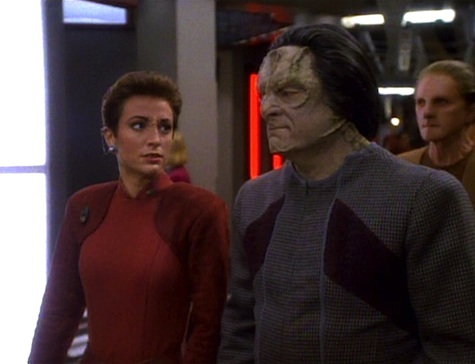
Lowest-rated episode: A tie between “A Man Alone” and “The Passenger,” both achieving only a 2.
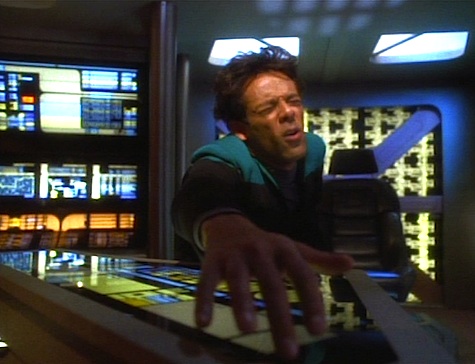
Most comments (as of this writing): “Emissary” with 101, only the second time we’ve cleared 100 comments (the other being TNG’s“Darmok”).
Fewest comments (as of this writing): “The Forsaken” with only 27, the only one to be under 30. What, no love for Lwaxana?
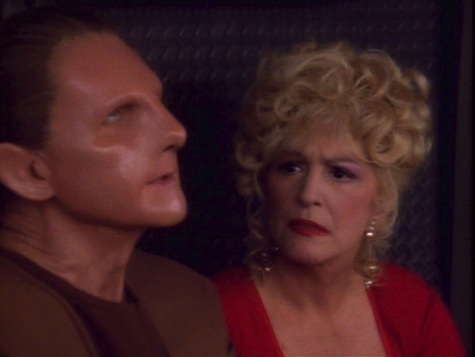
Favorite Can’t we just reverse the polarity?: From “If Wishes Were Horses”: “Perimeter sensors are picking up a subspace oscillation. What the hell does that mean?”
Kira speaking for us all.
Favorite The Sisko is of Bajor: From “Q-Less”: Sisko decks Q.
Nothing really to add there, it’s just so sufficiently spectacular that it’s worth repeating.
Sisko decks Q.
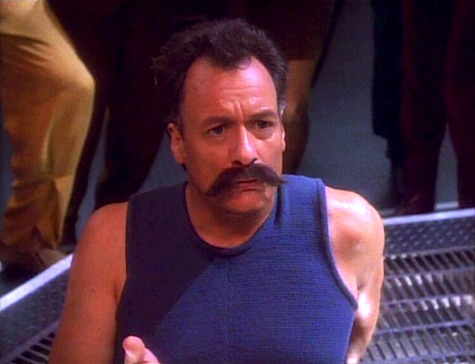
Favorite Don’t Ask My Opinion Next Time: From “Babel”: Kira shows some investigative chops—tracking Surmak through his signing of Dekon’s death certificate—and her underground training in doing whatever you need to do to get the job done via her basically kidnapping Surmak from his office. (She makes sure he’s alone in his office before beaming him out, and it’s an open question whether or not she’s doing it to avoid anyone else being transported or to avoid there being any witnesses.)
Kira also assumes that the device is Cardassian, but when further investigation reveals that it’s Bajoran, she’s completely unapologetic about the conclusion to which she originally jumped.
Favorite Rule of Acquisition: From “Q-Less”: Quark and Vash were made for each other. He sets up her auction, picking some select clientele—selected, as he explains to Odo, by virtue of their being incredibly wealthy and not too bright.
He also says “bid high and bid often,” a delightfully Ferengi play on the quote attributed to Chicago Mayor Richard Daley, “vote early and vote often.”
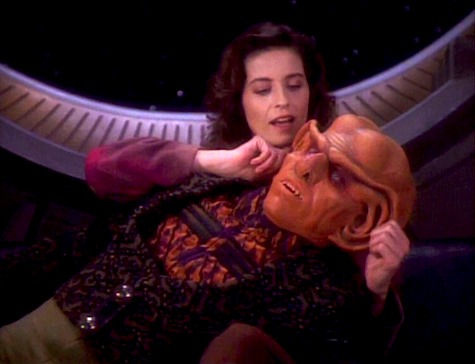
Favorite Preservation of mass and energy is for wimps: From “The Forsaken”: For the first time, we see Odo losing cohesion and being forced into his liquid form to regenerate, with Lwaxana catching him in the folds of her dress, a special effect that is utterly unconvincing either visually or scientifically. (Seriously, how did she keep it all in there? How was she able to support his weight?)
Favorite The slug in your belly: From “The Forsaken”: When Sisko was Curzon Dax’s adjutant, he used to delight in giving Sisko crap assignments very much like the one Sisko gives Bashir. When Bashir exasperatedly asks how he “graduated” from this duty, Sisko replies that it was when he hauled off and belted a VIP who was trying to get an unwilling ensign to go back to his quarters. Bashir gets a faraway look in his eyes, no doubt imagining that circumstance transplanted to his own situation, but Sisko puts the kibosh on it, as he’s less understanding than Curzon. Bashir is very obviously disappointed at having the hauling-off-and-belting option being taken off the table.
In addition, Lojal tries to insert himself into Dax’s scientific inquiry into the probe, thinking her too young and inexperienced. Bashir stops him, pointing out that she has three centuries’ experience.
Favorite For Cardassia! From “Emissary”: Dukat wastes no time in returning to his old stomping grounds to remind Sisko that he’s nearby and that his intelligence sources on Bajor are still quite good, mentioning that he knows that Sisko visited Opaka and brought an orb back. It’s clear that withdrawing from Bajor was not his idea and occurred over his objection.
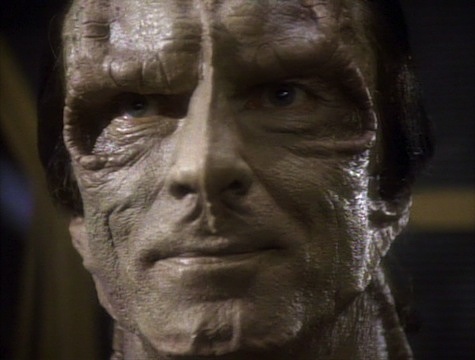
Favorite Plain, simple: From “Past Prologue”: We get our first look at the mysterious tailor who will become such a major part of the show. He befriends Bashir for reasons that likely range from the entertainment value of watching him thumpher about nervously in response to Garak’s possible double meanings to genuine use for him as a method of communicating covertly with Sisko (something Sisko himself figures out in short order). At this stage, it’s unclear what Garak is doing on the station beyond selling clothing. He’s willing to let Lursa and B’Etor believe that he still has pull on Cardassia, though we never see him actually contact home. Indeed, the only person he seems to get in touch with is Bashir, leading one to think that he promised the Klingon women payment he couldn’t come through with. (Of course, the Cardassians never got Tahna, so the Klingons wouldn’t be entitled to payment, exactly…) Either way, right off the bat we get Garak’s trademark charm, layered conversation, euphemisms, and torturing of Bashir, all continued hallmarks of the character.
Favorite What happens in the holosuite, stays in the holosuite: From “If Wishes Were Horses”: With all the humans coming to the station, Quark is considering opening up more holosuites that have family entertainment, in addition to the more sordid ones. This prompts Odo to call Quark disgusting, to which Quark replies happily, “Till the day I die.”
Favorite No sex, please, we’re Starfleet: From “A Man Alone”: Bashir continues to hit all over Dax, while Quark admires her from afar as well. Sisko also makes it clear that he has no sexual interest in Dax and the way is clear for Bashir to take his shot. Dax herself deflects Bashir by saying that Trill try to rise above such notions. This has the smell of bullshit being shoveled solely to deflect Bashir’s tiresome pursits, and that smell gets stronger when Sisko starts reminiscing about him and Curzon and the twins….
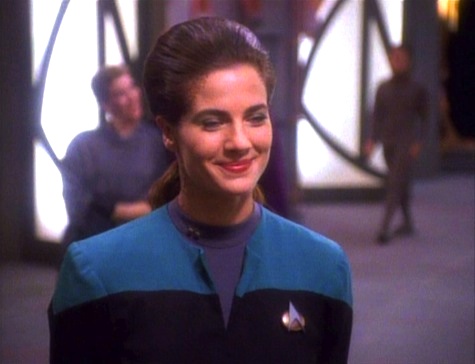
Favorite Welcome aboard: Lots of interesting guests this season, starting with the recurring characters who all make their debut: Marc Alaimo as Dukat (“Emissary,” “Duet”), Philip Anglim as Bareil (“In the Hands of the Prophets”), Felicia Bell as Jennifer (“Emissary”), Aron Eisenberg as Nog (“Emissary,” “A Man Alone,” “The Nagus,” “The Storyteller,” “Progress”), Louise Fletcher as Winn (“In the Hands of the Prophets”), Anne Gillespie as Jabara (“Babel”), Max Grodenchik as Rom (“Emissary,” “A Man Alone,” “The Nagus,” “Vortex”), Andrew J. Robinson as Garak (“Past Prologue”), Camille Saviola as Opaka (“Emissary,” “Battle Lines”), Wallace Shawn as Zek, and Tiny Ron as Maihar’du (both in “The Nagus”).
Then we have the Next Generation folks who came on over to the spinoff for a spell: Majel Barrett as Lwaxana (“The Forsaken”), Rosalind Chao as Keiko (“A Man Alone,” “If Wishes Were Horses,” “In the Hands of the Prophets”), John deLancie as Q (“Q-Less”), Hana Hatae as Molly (“A Man Alone,” “If Wishes Were Horses”), Jennifer Hetrick as Vash (“Q-Less”), Barbara March as Lursa (“Past Prologue”), Sir Patrick Stewart as Picard/Locutus (“Emissary”), and Gwynyth Walsh as B’Etor (“Past Prologue”).
Some excellent character actors did fine work this season as well: Michael John Anderson as Rumpelstiltskin (“If Wishes Were Horses”), Vaughn Armstrong as Danar (“Past Prologue”), Jonathan Banks as Shel-la (“Battle Lines”), Joel Brooks as Falow (“Move Along Home”), Cliff DeYoung as Croden (“Vortex”), Fionnula Flanagan as Enina (“Dax”), Gerritt Graham as the hunter (“Captive Pursuit”), Anne Haney as the magistrate (“Dax”), Gregory Itzin as Tandro (“Dax”), Scott MacDonald as Tosk (“Captive Pursuit”), Jeffrey Nordling as Tahna (“Past Prologue”), Randy Oglesby as Ah-Kel/Ro-Kel (“Vortex”), and Keone Young as Bokai (“If Wishes Were Horses”).
But nothing will beat two magnificent guest turns by two grand old men of the acting profession: Brian Keith as the irascible Mullibok in “Progress” and Harris Yulin as the troubled Marritza in “Duet.”
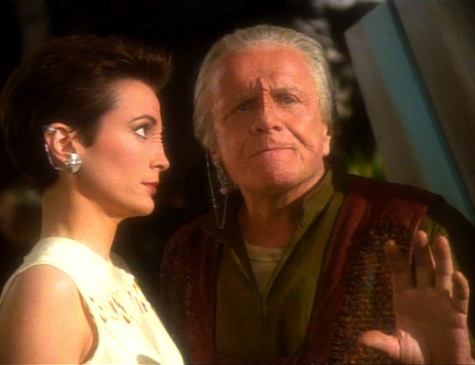
Favorite Keep your ears open: From “Emissary”: “This’ll be perfect! Real frontier medicine!”
“Frontier medicine?”
“Major, I had my choice of any job in the fleet.”
“Did you?”
“I didn’t want some cushy job or research grant. I wanted this! The farthest reaches of the galaxy, one of the most remote outposts available.This is where the adventure is, this is where heroes are made—right here, in the wilderness.”
“This ‘wilderness’ is my home.”
“I—I didn’t mean—”
“The Cardassians left behind a lot of injured people, Doctor. You can make yourself useful by bringing some of your Federation medicine to the natives. Oh, you’ll find them a friendly, simple folk.”
Bashir being an arrogant, pompous ass and Kira taking the piss out of him.
Favorite Trivial matter: Probably the one for “Emissary,” since the show picked up on so many different threads from so many different places, and set up so many more.
Walk with the Prophets: While the first season of DS9 is not its strongest, it’s still a good collection of science fiction stories that set the stage for what the show as a whole will accomplish. This is as strong a group of characters as you’ll find on any television show, and when they get to shine is one of two occasions when the show is at its best: Sisko’s struggles with being a single father (“Emissary,” “The Nagus”), Kira’s adjusting to life after the occupation (“Past Prologue,” “Progress,” “Duet,” “In the Hands of the Prophets”), Odo’s isolation and quest for his identity (“Vortex,” “The Forsaken”), Dax carrying the weight of her past lives (“Dax”), Jake and Nog’s developing friendship (“A Man Alone,” “The Nagus,” “The Storyteller,” “Progress”), and so on.
The other time the show is at its best is when it embraces what makes the show unique: its location near Bajor, recovering from the Cardassian occupation. Most of the season’s best stories deal with that particular aspect of the setting—with some exceptions, as there were strong episodes that didn’t deal with it (“Captive Pursuit”) and weak episodes that did (“The Storyteller”).
As the first spinoff of TNG, with producers understandably unsure of how the audience would respond, any number of TNG elements were included to ease the transition. Besides the obvious—the use of Cardassians and Bajorans, both introduced on TNG, and bringing the O’Brien family over from the Enterprise, as well as having Sir Patrick Stewart on hand in “Emissary” to pass the torch, as it were—there were the episodes “Past Prologue,” “Q-Less,” and “The Forsaken,” all using familiar guest stars from past (and future) TNG episodes.
Even the first season’s biggest problem—too many generic science fiction plots that could too easily have been used on any space opera show—was sometimes ameliorated by the uniquely DS9 elements, like the virus in “Babel” having its origins in Bajor’s resistance against the Cardassians.
Yes, it will be better when episodes that really dig into the characters and setting become more common than the technobabble-of-the-week episodes, but that’ll happen soon enough, and this first season did a fine job of introducing the show.
Warp factor rating for the season: 6
Keith R.A. DeCandido will be at Dexcon 16 this weekend in Morristown, New Jersey. He’ll have a table in the dealers room, so come on by and say hi.
Administrative note: There will be no rewatch on Friday the 5th because of the Independence Day weekend. We’ll be back on Tuesday the 9th with the second-season opener, “Homecoming.”










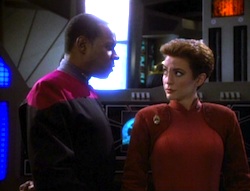
Only six more to go…
Heck, the whole series premise was largely a mix of TNG ideas: Cardassians from “The Wounded,” Bajorans from “Ensign Ro,” wormholes from “The Price,” Trill from “The Host,” Ferengi from various episodes, etc. And while Changelings were a new species, shapeshifters were anything but a new concept in Trek, though we saw them more in TOS than TNG.
I never even noticed there was a recurring nurse named Jabara. I had to look her up to know who you were talking about. I guess she didn’t have the same luck as Rom, Nog, Winn, etc. (or even Morn).
“It was also the first Trek show with a … female first officer”
Unless you count the original pilot.
LazerWulf: I don’t count a rejected pilot, no. :)
—Keith R.A. DeCandido
Well KRAD, I see you managed to basically reuse your intro from “Tales from the Dominion Wars” to open this article…
I jest, I jest.
You hit the nail on the head- too much of Season 1 could have been Next Generation episodes, or just about any othe science fiction show. The aspects that are unique to DS9 won’t really come out until Season 2 and later. One thing that can’t be overlooked though is the strong casting that was done- even though the characters get more developed as the seasons progress (Dax becomes less science officer and more adventurer; Bashir goes from innocent to superhuman) the cast really did click from early on in the show, which helps tremendously. None of the characters feel superfluous, nor do any seem larger than life.
Season 1 was a good start. We got to know the regulars and the world. The final two episodes of the season, especially, helped set the stage for the 3 parter at the start of season 2, which really stands out because it’s all about Bajor. Plus, it has a good villain.
Bobby
Of course I am a DS9 fan… but I am struck by how lucky/smart they were with the casting. After 1 season you can really see that they have a great group of regular/recurring characters for the show.
I finished my DS9 rewatch a while ago, while KRAD was still finishing his TNG work. So my memories are not as sharp as some of you.
But I’m currenty on my way through Voyager (just started season 4), and it’s remarkable just how awful that show is, especially compared to DS9. To date, the last few episodes of season 3 and the first couple of season 4 have been the only ones I thought were good, despite a few highlights here and there (Robert Picardo vs. Michael McKean? Yes please!). But the casting, the writing, and EFFING HARRY KIM have made most of the run so far utterly unappealing, like watching “Move Along Home” over and over again.
DS9, on the other hand, even in this first season, fired on almost all cylinders every week. Great ensemble, interesting suite of stories to tell, and a disinct level of anti-Roddenberry irreverence made DS9 by the far the best of the 5 shows–and this is best seen in comparison to the others.
While DS9 certainly had First Season Disease (typical of SFF shows having to find their footing), it started out better than Voyager (or, gods help us, the reprehensible Enterprise) ever got.
It’s my favorite of the franchise.
Watching the first season again after 20 years, I was underwhelmed. The show’s biggest asset is its regular cast. Unlike TNG, where the regular cast seemed stiff and unsure of themselves during the first season, this ensemble hits the ground running. This strong cast, along with some great guest stars, carried the first season. The biggest problem with the first season was a lack of direction. Although the actors had a handle on the characters, the writers didn’t have command of the storylines and themes. This seems to be a problem that has plagued all of the Trek TV series. Like the other Treks, DS9 will need two seasons to find its identity. In particular, there were times during the first season when it seemed that Berman and Piller were trying to do anything but sci-fi. There were too many episodes that were adaptations of TV dramas superficially set on a space station. There were more fantasy episodes than hard sci-fi. That peculiar combination would have sunk most TV sci-fi series. DS9 survived the first season because it inherited a loyal fan base from TNG. The best episodes were the series premiere (“Emissary”) and the penultimate episode (“Duet”). “Emissary” was strong enough to convince me to endure a lot of weak episodes and some real stinkers such as “Move Along Home” and “If Wishes Were Horses.”
We’ll have to endure another season of space drama before DS9 morphs into a more traditional TV space opera.
I agree that the writers played it a little too safe in the first season.
The use of TNG characters was not over bearing (taking away) from the DS9 cast.
@@.-@: Although the “The Cage” was rejected, much of it was incorporated into the TOS first season two-part episode, “The Menagerie.” Majel Barrett (née M. Leigh Hudec) was outstanding as Number One.
@12: Thank you for reminding us of what everyone already knows. But Keith’s point is that TOS didn’t have a regular female first officer. TOS’s first-officer character was Spock; Number One appeared only in flashbacks in one story.
I went through the rewatch with you but really saw very few little that made me think this might be a special show, something I’m only just now getting from season 5 which we finished tonight. It was a long time coming.
That first season I found most of the regular actors to be terrible (though they’ve all improved). The guest actors were often much better, and made the episodes watchable. I positively loathed the Bajoran religious episodes and any of the fantasy, signs of the mystic New Ageism (also to be found in Voyager to its detriment) that permeated 90s TV. And I’m only now caring about most of the characters. It shouldn’t take 5 seasons to get me to this place with a show.
But I’m here. I think I get it now. Onward and upward.
I wonder if when I finish this show I were to go back and watch it again, now caring more about the characters, would I like it more? I suspect I would. But that first time through was rough.
I have to say, the first season seems to have been better than I remembered it. In my head all the episodes were closer to “Move Along Home” or “If Wishes Were Horses”. And I would have placed some of the better or even middling episodes in later seasons. The show still has room for improvement, but the signs and directions are a lot clearer than I remembered.
On rewatching, I didn’t find season 1 to be as bad as I’d remembered it. The episode quality is a little hit and miss at times, with some of the A-plots being either terrible or very forgettable, but in terms of character development and relationships, there’s something to enjoy in every one. Keith’s comment of the episodes often being generic SF that could’ve been told on any series, but enhanced with aspects of the series’s backstory, is spot-on.
My main complaint for this season is that despite the cast forming a strong ensemble, a few of the main cast didn’t get sufficient focus. Bashir, for example, is still stuck in “insufferable mode”, with almost none of the charm that he’ll later display. Dax just doesn’t get enough to do in most episodes, and in a couple of them is stuck playing second fiddle to O’Brien. Meanwhile, Quark and Odo hog the limelight.
When I first re-watched the first season on DVD I remember wondering whether a disc was missing from the box set. Gul Dukat’s only in one episode, Garak’s only in one and there’s no Mirror Universe episode at all. Interesting that some of the most defining characteristics of the series are pretty much missing here and instead we get a series of stories set in the Trekiverse but, as many have pointed out, could have fitted into any Trek incarnation.
However, I reckon the greatest achievement of the first season was to show that it was possible to have a Star Trek series that did not involve a starship or trekking. The cast gel fairly well though agreed that the scriptwriters seem to be slightly lost with Dax and Bashir’s irritating mode is barely bearable.
It does seem as if the writing room was still worried about running stories over more than one episode, and to be fair the Babylon 5 effect was yet to take full effect and only soap operas had long story arcs. In fact, if memory serves, there’d only been the first B5 season which kept its arc story to a comparatively low level then. Please correct if I’ve got that wrong.
So, I would say strongest first season since the original series.
And just for the jollies, favourite episodes in transmission order:
‘Emissary’
‘Babel’
‘Q-Less’
‘Move Along Home’*
‘Dramatis Personae’
‘Duet’
and least favourite episodes:
‘Dax’
‘The Passenger’
‘The Storyteller’
‘Progress’*
*Yes I know but these are in the right lists:)
Dukat was actually in two episodes, “Emissary” and “Duet.”
—Keith R.A. DeCandido
@17: The pilot movie of Babylon 5 aired about halfway through DS9’s first season (the same week as “The Passenger”). B5’s first season premiered 11 months later, about halfway through DS9’s second season. So there was no “B5 effect” yet at this point in DS9’s history.
@14 shellywb
You’re not helping me out here. I’m still in S4, and you’re telling me I have to wait all the way for S5 before I’ll start to get it??? (I’m basing this on your past comments that I’m almost always in total agreement with.) I guess at least that means there is a light ahead, just far off.
About halfway through the season, I was really wondering where the Cardassians had gotten to. I remember later seasons were full of Cardassians and Dominion and such, and yet we get maybe…four? episodes with Cardassians, out of nineteen. The season started well and finished well, but the middle really left me wondering. In particular, the lack of Garak was very glaring after seeing him right at the beginning of the series. For me, that’s really what makes the first season weaker as a DS9 season. Not really because I like the Cardassians as a species (although “Duet” certainly shows us some of their depth), but because they feel like such a staple for the series as a whole.
@13 – I didn’t know that ;) But I haven’t seen much of TOS and obviously I’m an outlier in this group, anyway :) Although I’d agree that doesn’t count as a ‘regular’ female first officer.
I’m enjoying it so far, looking forward to the improvements to come. I will say, so far, I definitely prefer TNG and those characters. I just like the feel a little better. It’s a little interesting to me how so many people seem to love this show because it is so ‘anti-Roddenberry’ as some have put it, and goes against what the original vision was. I actually prefer TNG for that vision and I prefer idealized characters I can aspire to – to me when I think ‘Star Trek’ that’s the image I have, and DS9 is like a spinoff.
Not to say I think it’s bad or that I dislike that type of story – I don’t mean it is a negative criticism of DS9. And there is definitely something to be said for conflict when it comes to interesting stories to tell. But in my heart of hearts, so far I prefer TNG :)
Arguably, Voyager had Chakotay and Torres as being Maquis first, only taking on the Starfleet persona when they recognized that they were stuck in the middle of nowhere.
@22: I don’t think it’s accurate to say DS9 was opposed to Roddenberry/Trek values. Rather, it was about exploring them in a more nuanced way. It accepted that humanity could get better, but acknowledged that it was an uphill struggle and that it took a lot of hard work to maintain. Although I do think it took the darkness a little too far from time to time, especially in later seasons.
Fridge Logic: One of the big unanswered questions I’ve had about DS9 is what kind of relationship Q has with the Prophets. From what we’ve seen of both species, they seem to have much more in common with each other than they do with the humans/Bajorans. Why wouldn’t they compare notes?
@20 – I think DS9 really finds its identity in the latter half of S2 – more specifically, in the Garak-focused “The Wire”. If you ignore the Miror-universe episodes (which I hate and have nothing to do with the continuity), it leads to “The Collaborator” and “The Tribunal”. Both are good character pieces which set the stage for future conflicts, and of course the season ended with “The Jem Hadar”, which marked the start of the most ambitious story arc in the entire Trek universe.
Then again, the biggest jump in quality came late in S3, with “Improbable Cause”/”The Die is Cast”. Back when I first watched it live, that was the exact moment when I realized the show was something special.
@25: I don’t see how Q and the Prophets have any more in common with each other than, say, Ferengi and Tholians do. Sure, they’re both hyperadvanced, transtemporal, incorporeal intelligences, but the Trek universe is littered with those. Statistically speaking, given the sheer age of the universe and the way evolution works in Trek, such hyperevolved, godlike species probably outnumber corporeal intelligences. So there’s no reason to assume that any two given species on that level would have any familiarity with each other.
I remember years ago when rewatching the 1st season there is an episode with an extended shot of an alien strolling out of a door and onto the promenade. The alien looked very much like a Jem’Hadar (who are no introduced until later on). I’ve been trying to find the episode with no luck. Anybody else notice this amd know what episode it was? Pretty sure it was season one…anyways, its been driving mw nuts…maybe I’ll find it in season 2…
@27: You are probably thinking of “Captive Pursuit.” It was the 6th episode of Season One. It was reviewed on this blog.
If the Q are truly omniscient and the Prophets exist outside of our perception of time and space, then they almost certainly have to be aware of each other just by their very natures. Why would these beings pay so much attention to the likes of Picard or the Sisko, and not each other? It’d be like if the Monolith from 2001 were boxed up in a warehouse next to the Ark of the Covenant while we continued to test for algae and bacteria on the surface of Mars.
I actually wonder if all of those species are not only aware of each other, but also engaged in a kind of Cold War-esque game of maneuvering and proxy conflicts, and that Q’s behavior comes down to their attempts to circumvent the informal codes of conduct to their advantage. That would have made for a much more interesting story than the ‘Temporal Cold War’ from enterprise.
Just finished watching this season and was struck by how no crew members died in the entire season. As far as I recall, the Cardassian filing clerk was the only death. Kind of ironic given how the characters on this show are much less peace loving (“Picard never hit me” really sums up the cultural difference) Yet the TNG people got into a lot more fights and racked up a higher body count.
@30: Ensign Aquino was also murdered in this season. As far as other deaths, there was the clone who was killed in “A Man Alone.” There were the various hunters in “Captive Pursuit.” There was the hooligan who was shot in “The Passenger” as well as Rao Vantika (twice). There were the twins in “Vortex” (and whoever else was on the crew of the ship that got blown up on the nebula). There technically was Kai Opaka and all the people on that planet, but maybe you could discount them because of the resurrection thing. There was the original old storyteller in “The Storyteller.” There were all the Klingons on the ship in “Dramatis Personae.” And of course, as you point out, the filing clerk.
By comparison, the first season TNG deaths were Assistant Chief Engineer Singh, the two security guards killed by the Klingons in “Heart of Glory,” and Tasha Yar for the crew of the Enterprise. You might count the crew of Tsiolkovsky in “The Naked Now,” which may or may not put the body count higher depending on the size of the crew on the Klingon ship and whether you count the inhabitants of the prison planet. There was also the admiral in “Too Short a Season”, random scientists in “Home Soil,” and the third Klingon in “Heart of Glory.” “Symbiosis” is so forgettable to me that I don’t remember if anyone died, and quite frankly, I don’t care. I suspect that some of them maybe did. And then there’s “Conspiracy,” where at least one starship bites it and a bunch of Starfleet personnel get taken over/killed, not least of which is the guy who gets his head blown up on 80s television.
So yes, first season TNG did have a high body count. But there was much more than one death on first season DS9. There is potentially a high body count indeed depending on the crews of that Klingon vessel and the vessel in “Vortex” (and if you count the ressurected people).
@29: Well, sure, they’re aware of each other, but the point is, there are probably millions of other superraces they’re also aware of, so what are the odds that those particular two would have a special connection? I’m aware of the existence of Luxembourg and Burundi and Nepal and Kiribati, but I’ve never interacted with anyone from any of those places, as far as I know. It’s a big universe, and the problem with theories that try to link two Trek races that happen to have some coincidental similarity is that they assume the universe is tiny, that there’s nothing to it beyond what we see onscreen. That’s why it’s called “small-universe syndrome.”
@32 – I’m making two assumptions:
1. There are far fewer “superraces” than their ar “mundane” races.
2. Those superraces have more in common with each other than they do to the mundanes.
I can’t imagine any situation where the superraces would have more interest in the mundanes than they do with each other. The Prophets could barely understand Sisko’s perception of time, despite their involvement with Bajor; the Q seem perfectly comfortable with time travel and extradimensional existence. Wouldn’t it make more sense for them to communicate with each other before dealing with the puny Humans and Bajorans?
To use an in-universe example, the Vulcans didn’t give a damn about the Humans until they had FTL travel, which made relations between them worthwhile. Likewise, I can’t see the Prophets or the Q being so intimately involved in the day-to-day affairs of mere mortals without having first been much more intimately involved with each other.
And yet, from what we’ve seen, the Prophets are intimately wrapped up in Bajoran history, and the Q are legendary for mucking about with various races across the galaxy.
@33: I don’t buy assumption #1. Think about it. The universe is nearly 14 billion years old. Humanity has only existed for a few hundred thousand years, and Trek suggests that we’re already on the verge of evolving into superbeings (Wesley Crusher is arguably the first to make the transition). Statistics alone tells us that the galaxy probably has far more transcendent species than corporeal ones by this point. Not to mention that the Trek universe is littered with them — not just Q and Prophets, but Thasians, Trelane’s race, Organians, the Companion’s race, Gorgan’s race, the Zetarians, whatever V’Ger evolved into, the Sha Ka Ree entity, the Edo God, the Douwd, etc. Not to mention more corporeal yet still hyperadvanced races like the Talosians, Metrons, Olympian “gods,” Melkot, Vians, Excalbians, Vedala, Travelers, Cythereans, Nacene, and the like. And most of these were encountered by a single starship in the course of a few years. That suggests they exist in great abundance throughout the galaxy.
So I stand by what I said before. The Q and the Prophets are just two members of an extremely large category of species. They’re as likely to be aware of each other as any other randomly selected two, but since they are just two out of many, you’d need some actual evidence to support the idea that they had some specific connection that the many, many others didn’t.
And let’s consider the evidence we do have. Q visited Captain Picard and the Enterprise on at least eight occasions (or seven if you consider “Tapestry” to have been a dream), Captain Janeway and Voyager on three occasions, and DS9 exactly… once. If there were some kind of Q/Prophet connection, don’t you think Q would’ve visited more often? That he would’ve been involved in episodes pertaining to the Prophets and the wormhole? His near-total absence from DS9 argues that there is no specific connection between the Q and the Prophets — unless it’s some kind of mutual hostility or hands-off arrangement.
Really, why should the Prophets be any more aware of the Q than of anything else? They live in their own pocket universe, outside of time. The Q may be immortal and capable of traveling through time at a whim, but they exist within time, experiencing its passing much as we do. The Prophets have a limited ability to influence events in our spacetime, at least when those events occur near the wormhole, but generally need to possess corporeal beings to do anything in our realm; the Q, on the other hand, have effectively godlike power over our reality and can manipulate space, time, and matter on a whim. So yes, they’re both very advanced relative to us, but not in the same way. There’s no reason to think they’d have much in common with each other, or anything that would give them a specific connection. Just being really advanced in comparison to humans doesn’t cut it, not when there are so very many others that also are.
As mentioned on episode comment threads, it’s amazing how much a couple of bad episodes (particularly “Move Along Home” can make you forget how good this season really was.
@8 – folkbum: I don’t think it’s that anti-Roddenberry, but more of “let’s take Roddenberry’s premise and be a bit more realistic about it”.
@22 – Lisamarie: I prefer to aspire to be like people who are flawed, but can overcome those flaws, than people who by virtue of being perfect cannot have flaws, and therefore, have no merit when they behave like saints.
LtSheridan, I think the episode you mean is the S2 episode The Wire, when Dr Bashir is having lunch on the Replimat and we see an alien emerge from an airlock who looks very much like a Jem’Hadar (perhaps they were testing designs on this fella before settling on one in the season finale).
Crazydroid, only one scientist died in Home Soil, not two, by the MicroBrain controlling an industrial laser.
I wrote in the comment to the pilot that I never really liked DS9. The reason for this is that for me, Trek was always about “to boldly go where no man has gone before”. With a space station, this of course just isn’t possible. Now they just wait and let the adventures come to them, which is quite a boring premise, if you think about it.
DS9 feels more like a soap opera (I think someone in the comments coined the term space opera), a format I really don’t care much about (except for Twin Peaks, heh).
There where some good episodes and there are characters I care about (Odo, Kira, Jake and his father) and there are some really good relationships between some of the main cast (O’Brien and Bashir, Odo and Kira, Jake and Nog), so this is what kept me watching. Let’s see if season 2 can change my mind about DS9 being the worst of Trek.
“Emissary”-6
“Past Prologue”-6
“A Man Alone”-4
“Babel”-3
“Captive Pursuit”-6
“Q-Less”-2
“Dax”-8
“The Passenger”-2
“Move Along Home”-1
“The Nagus”-5
“Vortex”-5
“Battle Lines”-3
“The Storyteller”-3
“Progress”-9
“If Wishes Were Horses”-2
“The Forsaken”-6
“Dramatis Personae”-5
“Duet”-10
“In the Hands of the Prophets”-9
Average: 5.05
Overall-5. It’s a competently made season of tv, much more so than TNG’s first season. However, there are still far too many bland technobabble shows.
Just as a matter of history, while the term “space opera” has been referenced in the rewatch comments, it was not coined there. Space Opera is a old sub-genre of science fiction. It arose in the late 1920s, though there were stories earlier with some elements. Some examples include The Skylark of Space and the Lensman series by E.E. Doc Smith as well as works by Edmund Hamilton, John W Campbell and others.
Technically, Star Trek in all its versions is partly Space Opera. Like most works, they aren’t completely one sub-genre or another, but they share many of the characteristics of Space Opera.
Oh, no “technically” about it, Star Trek is 100% space opera.
—Keith R.A. DeCandido
@40
I was trying to be open to other interpretations. I’ve seen some folks (not on these rewatches) that claim Star Trek isn’t because it has too much focus on interpersonal relationships. Now, personally, while I love Space Opera, I do want some relationships. Why should I care about characters I don’t know? Star Trek usually succeeds at that, and any good Space Opera does as well. I was rooting for Dick Seaton and Dorothy to marry, as well as Crane and Peggy. I loved the relationship between Kimball Kinnison and Clarissa MacDougal. But other relations are important as well: friendships, rivalries, hatreds, and the entire panoply of human (and non-human) interactions.
@41/costumer: “I’ve seen some folks (not on these rewatches) that claim Star Trek isn’t [space opera] because it has too much focus on interpersonal relationships.”
That’s based on an unfeasibly narrow and profoundly outdated definition of “space opera.” There was a time when the label was used for broad, simplistic adventure fiction, and a time when it was scorned as a result, but in the past 2-3 decades, the label has been reclaimed for smart, rich, sophisticated works by authors like Alastair Reynolds, Iain M. Banks, Stephen Baxter, Catherine Asaro, etc. who have balanced sweeping cosmic adventure with sophisticated character writing and deep ideas.
Really, anyone who uses a genre label to build impassable walls and say “This is not allowed in here” is corrupting the idea of labels to serve their own petty desire to fight over boundaries. Labels don’t define things, they just describe them. Any given thing may be describable by multiple different labels at once, and any single label is just an approximate characterization of one aspect of the whole. Many works of fiction combine aspects of multiple different genres at once. Blade Runner is cyberpunk film noir. Star Wars is a sword-and-planet samurai Western space opera war movie. Genres are ingredients, not barriers. To use a physics metaphor, they’re bosonic rather than fermionic. Any number of them can coexist in the same space, rather than mutually excluding one another.
I agree completely, Christopher. I find it amazing how some people insist that things have to fit in tiny, narrow boxes.
Krad, your favourite Garak moment would have to be from Past Prologue since that’s the only time he appears in S1, so that certainly narrowed it down.
I thought this was a very impressive season, and I’m surprised that it’s not remembered more fondly. It only had two real classics (Progress, Duet), but that’s two more than TNG’s debut had, and there were only three episodes I actually disliked (A Man Alone, The Passenger, The Storyteller), all of which had enough going for them that I didn’t actually hate watching any of them. Obviously it’s not on par with the debut of the original series, which continues to be my favorite season during this rewatch, but it’s at least as good as the second season of TOS and nearly as good as the fifth season of TNG.